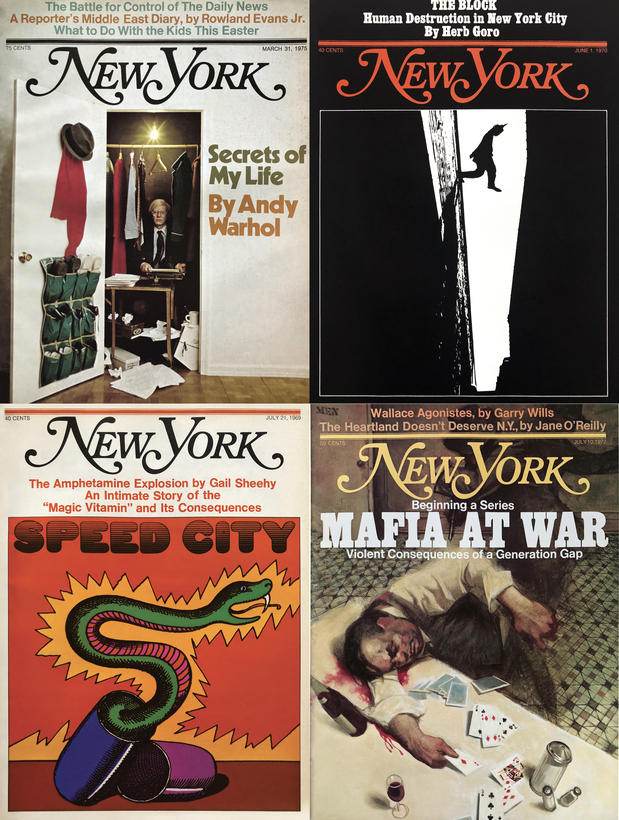It’s always good to have friends in high places. In 1968, when my friend Milton Glaser started New York magazine with Clay Felker, I became one of its regular illustrators. This brash new weekly didn’t pay a lot, but it gave me something I coveted more—a chance to write and illustrate my own ideas. Appearing in New York changed my career, just as it did the careers of Tom Wolfe, Gloria Steinem, Jimmy Breslin, James McMullan, Nora Ephron, and the dozens of others who were given their big chance to strut their stuff.
In Mag Men: Fifty Years of Making Magazines, by Walter Bernard and Milton Glaser, we get the inside scoop on how New York magazine came into being, plus a dazzling show-and-tell of about 25 of the hundreds of periodicals that these two designed. Bernard was the art director at New York, while Glaser, who with Clay Felker created the magazine, was listed as design director. But Glaser not only decreed how the magazine would look, he had a voice in influencing its editorial direction as well. In the book, Glaser describes his differences with Felker this way: “Inevitably, we had different views of the city. I loved the Lower East Side—cheap food and left-wing politics. Clay, with his outsider curiosity, was obsessed with the city’s power establishment and the lives of the rich, the talented, and the perverse.”
Close Quarters
Their arguments took place in a room into which the entire staff had been squeezed—hardly a suitable place for shouting matches. Felker did, it’s true, have an office with walls, but they didn’t go up to the ceiling. Conversations could be overheard. Glaser remembers that most of their fights started with Clay’s demand that something be made bigger. “No matter what it was—a photograph, the text type, the headline, the pull quotes—Clay’s reaction to any layout was always the same, ‘Make it bigger.’ My standard response, before I lapsed into profanity, was always ‘When everything is big, nothing is big,’ a clever response that did me no good.”

The pictorials from New York reproduced in Mag Men (with better production values than they originally had in the magazine) still astonish with their originality and wit. My favorite visual extravaganza was the one they did on Watergate, for which they hired nine illustrators to depict every aspect of the break-in and its aftermath. Three issues were devoted to this “You Are There” project, where painters did the job that cameras were unable to do. There has not been anything like it since.
“Make it bigger,” Clay would say. “When everything is big, nothing is big,” Milton would counter.
Then suddenly, in December of 1976, it was over. Here is all that Walter Bernard chose to say about it. “Clay Felker stood on a desk to tell us that he had failed to stop Rupert Murdoch’s hostile takeover of New York magazine. The news was devastating. We all gathered at an Irish bar that evening and together with our families, mourned the end of a joyful era.”
Clearly the authors don’t want to talk about how Murdoch managed to win control, even though it’s a nifty tale of the businessman’s skullduggery and Felker’s overarching ambition. But you’ll have to read about that elsewhere. What we do learn is that when New York succumbed to Murdoch, Walter was invited to redesign Time magazine, and in the next three years he redesigned four other titles. And we are surprised to hear Milton confess in Mag Men that he had lost interest in magazines at the time of the takeover. “I feel nervous about doing the same thing day after day,” he writes. Milton soon had another big project, redesigning the Grand Union supermarket chain.
Then suddenly, in December of 1976, it was over.
The middle section of Mag Men is devoted to the magazines that each of the authors worked on separately. It includes Bernard’s redesign of The Atlantic Monthly, which I regard as his most elegant creation, and Glaser’s overhaul of Paris Match, which was accomplished in one weekend, when he just happened to be in Paris to work with a different client.
In 1982, when Ben Bradlee called Bernard to redesign The Washington Post, and Sir James Goldsmith asked Glaser if he would redesign Lire, a French literary magazine, it suddenly made sense for them to get back to working collaboratively. This last section of the book is devoted to the work they did after they formed WBMG. No matter how many magazines they worked on, they gave each one its own personality. The only thing they all have in common is beautiful design, good typography, and, very often, a mischievous sense of fun.
In 2013, Bernard and Glaser received the American Society of Magazine Editors Creative Excellence Award. Open up Mag Men to any page and you’ll see why.
Edward Sorel’s memoir, Profusely Illustrated, will be published by Knopf in 2021


